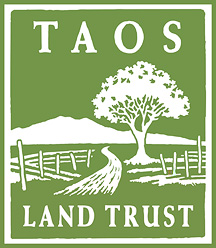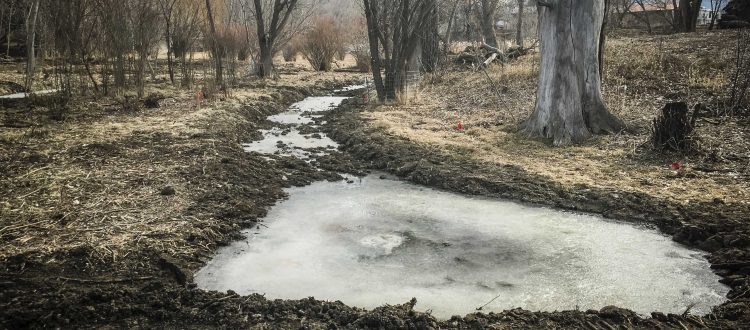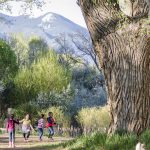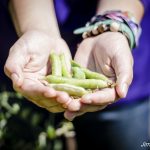BIG…Update on the Rio Fernando River Restoration Work. BIG.
Rio Fernando Park is blanketed in a thick layer of lovely white snow and we are expecting more before the weekend. For now, river restoration work on our seven-acres section of the Rio Fernando is complete. The machinery work is totally done and we now have to wait until spring wends its way up the valley and around through the leave of the cottonwoods before we can move on to the next stage of the restoration work. That means that this is the perfect time to update you all on what we’ve done, share our restoration video, tell you what is next and to see what questions you
might have.
Land Forms
The water table in Rio Fernando Park is quite high. That kept us from cutting the whole of the channel to reroute the river to its historic, natural channel. The machines run by the Keystone Restoration Ecology crew started to sink! But we did get about 95% of it. This shouldn’t present us with any problems because we expect the water to do the rest of the work. If it doesn’t, we can get out there with our shovels and take care of it pretty easily. But for now, we will just let it be and we will assess after spring runoff.
That spring runoff will help everything. Especially if the snow keeps up! It will help to carve the channels, clean them, create habitat features, move the gravel and spread the gravel we placed in the channels. Essentially, it will take the work we did and just make it better.

The snowfall so far this winter has been good but we need more. If and when we get a good spring flood – and hopefully that will be coming in just a few months – we want the water to overflow the stream channel and fill the ponds. The land-shaping we did should slow the water, limit the amount of erosion and prevent head-cuts. Ideally, the whole wetland will fill in this spring. We hope to have the water create 4-6 ponds. Man, would that make for some happy beavers – not to mention the birds! If after spring runoff we don’t see the water going where we want it to go it will be fairly easy to make adjustments. Again, some simple shovel work should take care of it. You can think of these ponds and landscape structures as “relief valves” in case one day we get a really big flood.
It is worth noting that when we did the planning for the restoration work, we planned in the possibility of a historic flood. Twenty years of stream gauge data shows us that the Rio Fernando might have historically flowed at about 160 cubic feet/second (cfs) with occasional floods taking that much higher. in that time period. However, because so much of the Rio Fernando is used for irrigation, we normally only get about 1-2cfs and topping out at 40cfs during really big flows. In the design however we took into account what the watershed and the landforms indicated for flows, not the current numbers. Why? In case of a big flood one day. Our wetland will be able to disperse the energy of the flood protecting downstream users and storing that water for slow release.
Vegetation
As I’m sure you all know by now, we took out a large number of invasive Russian olive trees. These beasts were one of the major impediments to restoring the stream to a proper functioning system. We expect that the willows will now start to sprout in new areas where we took out the Russian olives. But we will need to plant them where they don’t exist to help them gain a firm foot hold in the wetland. We’ve ordered them and what we learned last summer is that if we soak them until they sprout, they will have a much better survival rate once they are planted. The Coyote (Red) Willow spreads easily. The Bluestem, Black and Peachleaf willow will need some help. We will wait until summer to plant the willows. We’ve also ordered the following to plant in the wetland in the summer:
- Serviceberry
- Thinleaf alder
- Mountain Snowberry
- Arizona Ash
- Peachleaf willow
- Bluestem willow
- Water birch
- Box elder

We do expect the Russian olive to re-sprout. This is one tough tree and we are determined not to use herbicides and other poisons to deal with it (must to the chagrin of some restoration experts…) but we are determined to protect the waters and lands in the park and the health of our community so I imagine we will be hitting the olive re-sprouts by hand again and again over the coming years. AND…since those awesome YCC youth will be back this summer we will have extra hands to do the work! We’ve applied for a grant to do more olive removal downstream next fall but we won’t be moving the stream channel there. Like I said, all the big work is complete.
We aren’t sure what will happen with the Canadian thistle. It is the worst of all the invasive weeds we’ve had to deal with at the park. During the restoration we took the areas where it was growing and the remains that the YCC pulled out last summer and we buried them deep. We will just have to see if they come back up. We think they wont but….they are one tough plant.
We sodded the berms that were built in the wetland with grassy
patches from other areas where we had decent confidence that there weren’t many invasives. That said, weeds could poke through in the spring and we will have to deal with those by hand.
Just before the snow arrived, we were able to get Western wheatgrass down on the barespots where the tractors had had their largest impact. The thick web of roots the wheatgrass produces will help to limit the growth of the thistle. In the summer we will also plant juncus balticus, a species of rush, that will also help limit the growth of Canadian thistle.

As far as the teasel goes…the YCC crew made awesome progress last summer. We think that two more years of concerted efforts to get rid of this invasive will take care of it for the most part.
In the pond we will plant Soft stem bulrush along the rim while leaving the center open for waterfowl. Keeping the center of the pond might
require occasional maintenance work. Ideally not but it is one of those things that we will just have to see. It is also worth
noting that as the water table comes up we might see a loss of some of the ash trees as they aren’t so fond of a really wet wetland – that is something we expect. It might be that as the beaver move back in they will take the ash down anyway.
Monitoring
For the next several years we will do some intensive monitoring of the project area. Just before the snow began to fall, I was able to set up 22 photo monitoring points, stake them and get them located with the GPS unit. Gak Stonn of Taos Print and Photography Services was kind enough to do a drone overflight of the wetland before we began the work and he will be back for follow up drone flights after the snowmelt. The footage from the drone flights is pretty amazing and we will put together a before and after comparison video for you to see sometime in the spring. The monitoring will also include longitudinal profiles and cross sections as well as the water quality and quantity monitoring, we’ve been working on with the Taos High School crew and Amigos Bravos. We will also do some intensive vegetation monitoring at the end of the summer. Thanks to the Taos High School Eco-Statistics class we will have pre-restoration and post-restoration data to help us assess the changes and impact of our work.
Listen to our podcast interview with Jen Vrooman of Keystone Restoration Ecology
We will do a report to the Army Corps of Engineers and the National Recreation and Parks Association in May and again in December 2019. We will try to make those reports available to you here on our website.
But really, the main thing now is that we need to wait and see what happens with waterflow, the water table, the weeds, the beavers and the wetland plants. We’ve made a heck of a lot of progress the past six months but we do have a long way to go. We have a bunch of questions we want to get answers to over the coming year or two: Are the structures we built in the wetland improving things? Are they breaking? Is the wetland growing? Is the wetland improving?
It’s unclear what got the beavers in a rush but about the time we started the restoration work they went to town on the Russian olives downstream, taking down dozens of them and expanding the dam quite a bit. The water table is 2-3 feet higher than it was before. I also established three photos points to monitor the growth of the dam while Kineo set up the wildlife camera traps. We will for sure share with you whatever we get from those!
And that is where we are at the moment with the Rio Fernando Park River Restoration. Be sure to watch the video we created about the restoration work as it has a lot more information about the work we did.
Hit us up with any questions!
Special thanks to Steve Vrooman and Jen Vrooman of Keystone Restoration Ecology, Mark Schuetz, Americorps, Peter Walker and the Digital Media Arts program at UNM, Dominick and Sky, Keystone Restoration Ecology, Taos High School, Gak Stonn and Taos Print and Photography Services among many many others!



